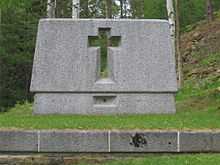Ležáky

Ležáky (German: Ležak, from 1939: Lezaky), a part of municipality of Miřetice, was a village in Czechoslovakia. During the German occupation of Czechoslovakia the village was completely razed to the ground by Nazi forces during the reprisals for the assassination of Reich Protector Reinhard Heydrich in the late spring of 1942.[1]
History
Ležáky was a settlement inhabited by poor stone-cutters and little cottagers. It was composed of eight houses concentrated near the mill; this mill had created the basis for the village named after the rivulet Ležák.
Since 24 September 1941, SS-Obergruppenführer and General of Police Reinhard Heydrich had been Acting Reichsprotektor of the Nazi Protectorate of Bohemia and Moravia.[2] This area of the former Czechoslovakia had been occupied by Nazi Germany since 5 April 1939.[2]
In December 1941 several Allied paratroopers were dropped into the Protectorate Bohemia and Moravia. Some of them were sent to assassinate Reinhard Heydrich in a planned action known as Operation Anthropoid, and another group was part of Operation Silver A. Several people from Ležáky helped this group, providing a hiding place for their radio set.[3]
On the morning of 27 May 1942, Heydrich's car was attacked by the Czech and Slovak soldiers (on behalf of the Czechoslovak government-in-exile), Jozef Gabčík and Jan Kubiš.[4] Heydrich died on 4 June 1942.
Massacre

After the assassination of Heydrich, the revenge of the Nazis started with martial law. Then on 10 June the village of Lidice was razed to the ground and its male inhabitants shot. The Nazi regime chose that village because its residents were suspected of harbouring local resistance partisans and were falsely associated with aiding Operation Anthropoid team members.[5]
Thereafter, Gestapo agents found the radio transmitter in Ležáky which belonged to Operation Silver A.[6] Alfréd Bartoš, the leader of resistance group Silver A, committed suicide in a hopeless situation. On 24 June, approximately 500 SS troops and policemen surrounded Ležáky, took away all the inhabitants and the village was reduced to "rubble". All 33 villagers (both men and women) were shot.[6] Thirteen children were separated from their families. On 26 June a press release announced the event publicly. In mid-December 1943, the débris of Ležáky was pulled down by 65 men from Nazi work camps.[7]
The sisters Jarmila and Marie Šťulík were selected for the 'Aryanisation' programme (both were found and returned after the war). The remaining 11 children were sent to the Chełmno extermination camp and in summer 1942 gassed (together with one girl from Lidice).[7]
Unlike Lidice, Ležáky was not rebuilt after the war, and only memorials exist today.
See also
References
- ↑ Gerwarth 2011, pp. 280, 285.
- ↑ 2.0 2.1 Kaplan and Nosarzewska, Prague: The Turbulent Century p. 214
- ↑ Gerwarth 2011, pp. 280-285.
- ↑ Kaplan and Nosarzewska, Prague: The Turbulent Century p. 241
- ↑ Gerwarth 2011, p. 280.
- ↑ 6.0 6.1 Gerwarth 2011, p. 285.
- ↑ 7.0 7.1 "The History of Ležáky Memorial 1942 - 1943". Ležáky Memorial.
Literature
- Jarmila Doležalová (one of the two children that survived the war), František Vašek: Křižovatky času – Ležáky v datech (Crossroads of time - Ležáky in dates), 2007. History of the village since first written mention until today.
- Gerwarth, Robert (2011). Hitler's Hangman: The Life of Heydrich. New Haven, CT: Yale University Press. ISBN 978-0-300-11575-8.
- Kaplan, Jan and Nosarzewska, Krystyna (1997). Prague: The Turbulent Century, Koenemann Verlagsgesellschaft mbH, Koeln. ISBN 3-89508-528-6
- Vojtěch Kyncl: Ležáky - Obyčejná vesnice, SILVER A a pardubické gestapo v zrcadle heydrichiády, 2009, (cz PDF), ISBN 978-80-7415-009-8
External links
- Official Website (cz,en,de,ru)
- Website dedicated to the village, photogallery (cz, en, de)
Coordinates: 49°49′57″N 15°54′01″E / 49.83250°N 15.90028°E
| |||||||||||||||||||||||||

